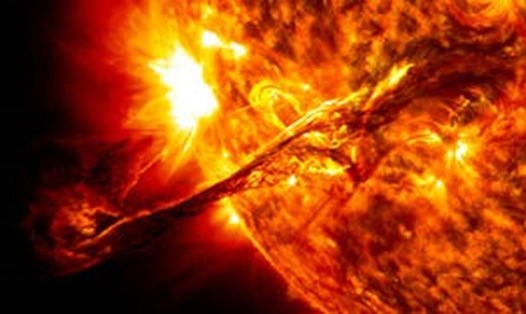A new study on ancient ice models has discovered that this unprecedented solar storm is one of the strongest reflections of the Sun, to the point that it could paralyze modern communication systems if it hits Earth today.
According to research results recently published in the journal Nature Communications, the most difficult thing to explain is that a major storm seems to have broken out at the center of the Sun - the time in the 11-year cycle when solar energy outbreaks are rarely the most likely to occur.
With this surprising discovery, researchers are concerned thatterally destructive solar storms could hit as soon as we least expected and the Earth could not be prepared for the next major storm.
These huge storms have not yet been fully assessed for risk, said co-author Raimund Muscheler, a geologist at Lund University in Sweden. The most important thing is to analyze what these events could mean for today's technology and how we can protect ourselves."
When the Earth is attacked
Sun storms occur when the forces from the solar system - the outer atmosphere of the Sun - become chaotic, soar and fall violently. This could release plasma flows and giant magnetic fields called the compass (CME), which could plunge out of the Sun's atmosphere into space at a very high speed.
If a CME crashes toward Earth, it could put pressure on the planet's magnetic shield, causing what is called a geometeorological storm.
Light tropical cyclones could damage satellites and disrupt radio transmissions. Meanwhile, serious storms, such as the "Halloween storm" in 2003, could cause widespread power outages worldwide and permanent damage to power infrastructure, such as power transformers. Some researchers are concerned that a large enough solar storm could also destroy underwater Internet cables, leading to an " Internet End" that would leave a large part of the world's population unconnected for months.
CME outbreaks typically peak after each cycle of 11 years or longer, when they operate from within the circums of the sun at the highest level.
Today, satellites can directly track solar energy outbreaks. But finding evidence of ancient storms requires more complex research at the nuclear level. The authors of the new study have looked for evidence of special particles called cosmic radioactive atoms. Basically, radioactive monosomes are created when solar particle masses collide with elements in the Earth's atmosphere.
These radioactive particles may appear in tree trunks and ice core. Specifically, in this study, scientists analyzed some of the ice core drilled in the South and Greenland. The core of ice collected from both locations showed a significant spike in the radial atoms beryllium-10 and clo-36 about 9,200 years ago, suggesting that an extremely strong solar storm had swept across the Earth at that time.
A deeper analysis found the Sun storm at an exceptionally strong level perhaps equivalent to the strongest Sun storm ever recorded, which occurred during the Suns extreme cycle between the years 775 BC and 774 AD.
However, the 9,200-year-old solar storm returned to life during the transit period, when the magnetic activity in the Sun should have been low. This has left the authors confused and worried because it is clear that the Earth is not ready for the same thing to happen.
This storm increases the likelihood of a worst-case scenario for solar typhoon events, they wrote in the research report.
According to the authors, scientists need to look for more extreme, older storms in ice core and belt records today to determine whether there is any model outside the Sun's 11-year cycle that can determine when most extreme storms will occur.








